Mr. Paisley's Case Study: Diabetic Foot Ulcer and Nursing Care
VerifiedAdded on 2023/01/12
|10
|2783
|30
Case Study
AI Summary
This case study focuses on Mr. Arthur Paisley, a 70-year-old male admitted post-surgical debridement of a non-healing left diabetic foot ulcer. The assignment delves into the patient's medical history, including Type 2 diabetes mellitus, poorly controlled blood glucose levels, peripheral vascul...
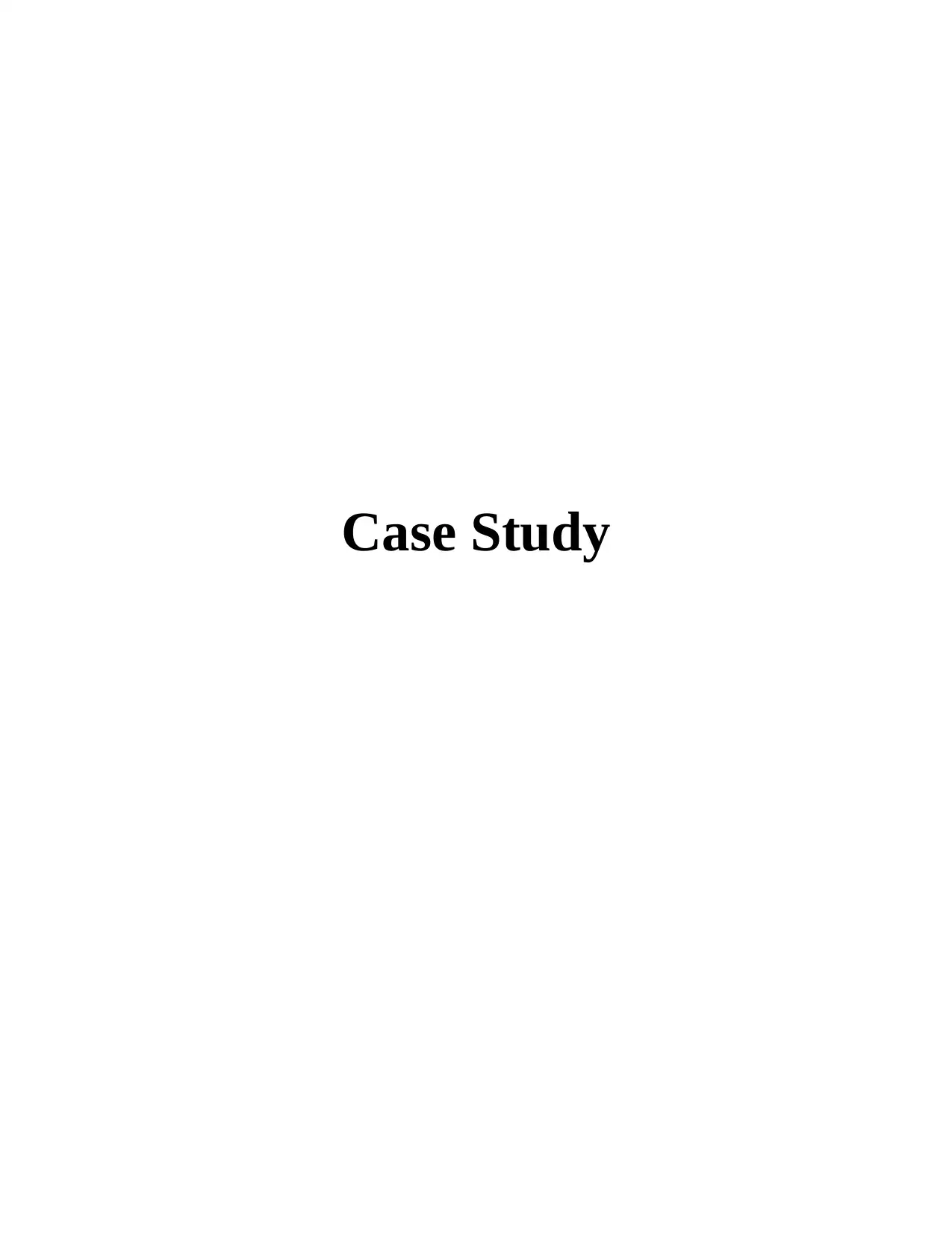
Case Study
Paraphrase This Document
Need a fresh take? Get an instant paraphrase of this document with our AI Paraphraser

Table of Contents
INTRODUCTION...........................................................................................................................3
MAIN BODY...................................................................................................................................3
Explain any abnormal findings would you need to consider in your assessment? Ensure you
use appropriate literature to support your suggestions................................................................3
Outline the pathophysiology of why Mr Paisley’s diabetic foot ulcer may not have healed
related to his recent medical history............................................................................................4
Identify and discuss three (3) specific nursing care interventions you will need to undertake
for Mr Paisley this morning after his surgery. Provide rationales for your interventions..........6
The inter-professional team that works with Mr Paisley includes physiotherapists,
pharmacists, occupational therapists, social workers and dieticians. Pick one member of the
inter-professional team and discuss their role in safely discharging Mr Paisley from hospital..7
CONCLUSION................................................................................................................................8
REFERENCES................................................................................................................................9
INTRODUCTION...........................................................................................................................3
MAIN BODY...................................................................................................................................3
Explain any abnormal findings would you need to consider in your assessment? Ensure you
use appropriate literature to support your suggestions................................................................3
Outline the pathophysiology of why Mr Paisley’s diabetic foot ulcer may not have healed
related to his recent medical history............................................................................................4
Identify and discuss three (3) specific nursing care interventions you will need to undertake
for Mr Paisley this morning after his surgery. Provide rationales for your interventions..........6
The inter-professional team that works with Mr Paisley includes physiotherapists,
pharmacists, occupational therapists, social workers and dieticians. Pick one member of the
inter-professional team and discuss their role in safely discharging Mr Paisley from hospital..7
CONCLUSION................................................................................................................................8
REFERENCES................................................................................................................................9
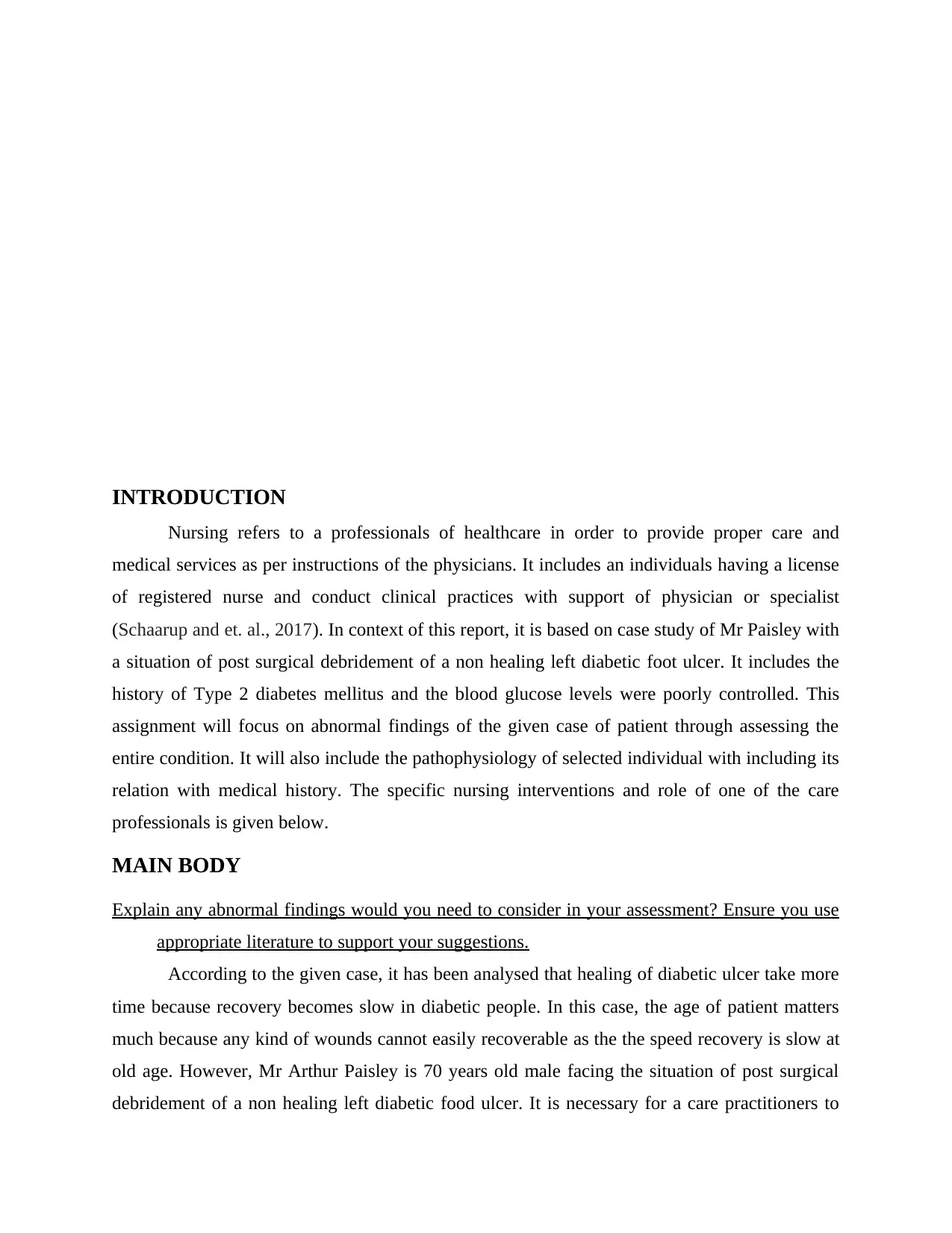
INTRODUCTION
Nursing refers to a professionals of healthcare in order to provide proper care and
medical services as per instructions of the physicians. It includes an individuals having a license
of registered nurse and conduct clinical practices with support of physician or specialist
(Schaarup and et. al., 2017). In context of this report, it is based on case study of Mr Paisley with
a situation of post surgical debridement of a non healing left diabetic foot ulcer. It includes the
history of Type 2 diabetes mellitus and the blood glucose levels were poorly controlled. This
assignment will focus on abnormal findings of the given case of patient through assessing the
entire condition. It will also include the pathophysiology of selected individual with including its
relation with medical history. The specific nursing interventions and role of one of the care
professionals is given below.
MAIN BODY
Explain any abnormal findings would you need to consider in your assessment? Ensure you use
appropriate literature to support your suggestions.
According to the given case, it has been analysed that healing of diabetic ulcer take more
time because recovery becomes slow in diabetic people. In this case, the age of patient matters
much because any kind of wounds cannot easily recoverable as the the speed recovery is slow at
old age. However, Mr Arthur Paisley is 70 years old male facing the situation of post surgical
debridement of a non healing left diabetic food ulcer. It is necessary for a care practitioners to
Nursing refers to a professionals of healthcare in order to provide proper care and
medical services as per instructions of the physicians. It includes an individuals having a license
of registered nurse and conduct clinical practices with support of physician or specialist
(Schaarup and et. al., 2017). In context of this report, it is based on case study of Mr Paisley with
a situation of post surgical debridement of a non healing left diabetic foot ulcer. It includes the
history of Type 2 diabetes mellitus and the blood glucose levels were poorly controlled. This
assignment will focus on abnormal findings of the given case of patient through assessing the
entire condition. It will also include the pathophysiology of selected individual with including its
relation with medical history. The specific nursing interventions and role of one of the care
professionals is given below.
MAIN BODY
Explain any abnormal findings would you need to consider in your assessment? Ensure you use
appropriate literature to support your suggestions.
According to the given case, it has been analysed that healing of diabetic ulcer take more
time because recovery becomes slow in diabetic people. In this case, the age of patient matters
much because any kind of wounds cannot easily recoverable as the the speed recovery is slow at
old age. However, Mr Arthur Paisley is 70 years old male facing the situation of post surgical
debridement of a non healing left diabetic food ulcer. It is necessary for a care practitioners to
⊘ This is a preview!⊘
Do you want full access?
Subscribe today to unlock all pages.

Trusted by 1+ million students worldwide
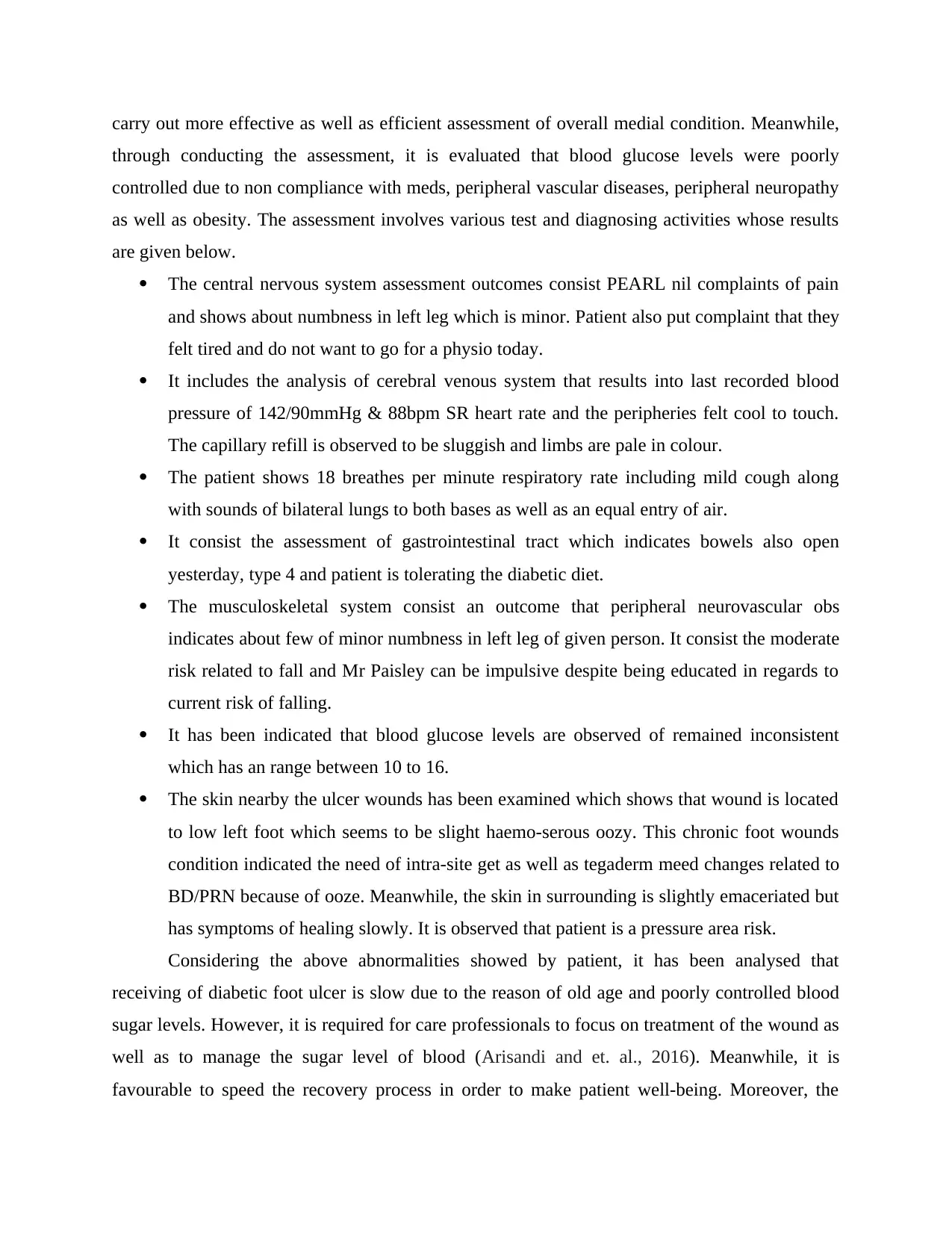
carry out more effective as well as efficient assessment of overall medial condition. Meanwhile,
through conducting the assessment, it is evaluated that blood glucose levels were poorly
controlled due to non compliance with meds, peripheral vascular diseases, peripheral neuropathy
as well as obesity. The assessment involves various test and diagnosing activities whose results
are given below.
The central nervous system assessment outcomes consist PEARL nil complaints of pain
and shows about numbness in left leg which is minor. Patient also put complaint that they
felt tired and do not want to go for a physio today.
It includes the analysis of cerebral venous system that results into last recorded blood
pressure of 142/90mmHg & 88bpm SR heart rate and the peripheries felt cool to touch.
The capillary refill is observed to be sluggish and limbs are pale in colour.
The patient shows 18 breathes per minute respiratory rate including mild cough along
with sounds of bilateral lungs to both bases as well as an equal entry of air.
It consist the assessment of gastrointestinal tract which indicates bowels also open
yesterday, type 4 and patient is tolerating the diabetic diet.
The musculoskeletal system consist an outcome that peripheral neurovascular obs
indicates about few of minor numbness in left leg of given person. It consist the moderate
risk related to fall and Mr Paisley can be impulsive despite being educated in regards to
current risk of falling.
It has been indicated that blood glucose levels are observed of remained inconsistent
which has an range between 10 to 16.
The skin nearby the ulcer wounds has been examined which shows that wound is located
to low left foot which seems to be slight haemo-serous oozy. This chronic foot wounds
condition indicated the need of intra-site get as well as tegaderm meed changes related to
BD/PRN because of ooze. Meanwhile, the skin in surrounding is slightly emaceriated but
has symptoms of healing slowly. It is observed that patient is a pressure area risk.
Considering the above abnormalities showed by patient, it has been analysed that
receiving of diabetic foot ulcer is slow due to the reason of old age and poorly controlled blood
sugar levels. However, it is required for care professionals to focus on treatment of the wound as
well as to manage the sugar level of blood (Arisandi and et. al., 2016). Meanwhile, it is
favourable to speed the recovery process in order to make patient well-being. Moreover, the
through conducting the assessment, it is evaluated that blood glucose levels were poorly
controlled due to non compliance with meds, peripheral vascular diseases, peripheral neuropathy
as well as obesity. The assessment involves various test and diagnosing activities whose results
are given below.
The central nervous system assessment outcomes consist PEARL nil complaints of pain
and shows about numbness in left leg which is minor. Patient also put complaint that they
felt tired and do not want to go for a physio today.
It includes the analysis of cerebral venous system that results into last recorded blood
pressure of 142/90mmHg & 88bpm SR heart rate and the peripheries felt cool to touch.
The capillary refill is observed to be sluggish and limbs are pale in colour.
The patient shows 18 breathes per minute respiratory rate including mild cough along
with sounds of bilateral lungs to both bases as well as an equal entry of air.
It consist the assessment of gastrointestinal tract which indicates bowels also open
yesterday, type 4 and patient is tolerating the diabetic diet.
The musculoskeletal system consist an outcome that peripheral neurovascular obs
indicates about few of minor numbness in left leg of given person. It consist the moderate
risk related to fall and Mr Paisley can be impulsive despite being educated in regards to
current risk of falling.
It has been indicated that blood glucose levels are observed of remained inconsistent
which has an range between 10 to 16.
The skin nearby the ulcer wounds has been examined which shows that wound is located
to low left foot which seems to be slight haemo-serous oozy. This chronic foot wounds
condition indicated the need of intra-site get as well as tegaderm meed changes related to
BD/PRN because of ooze. Meanwhile, the skin in surrounding is slightly emaceriated but
has symptoms of healing slowly. It is observed that patient is a pressure area risk.
Considering the above abnormalities showed by patient, it has been analysed that
receiving of diabetic foot ulcer is slow due to the reason of old age and poorly controlled blood
sugar levels. However, it is required for care professionals to focus on treatment of the wound as
well as to manage the sugar level of blood (Arisandi and et. al., 2016). Meanwhile, it is
favourable to speed the recovery process in order to make patient well-being. Moreover, the
Paraphrase This Document
Need a fresh take? Get an instant paraphrase of this document with our AI Paraphraser
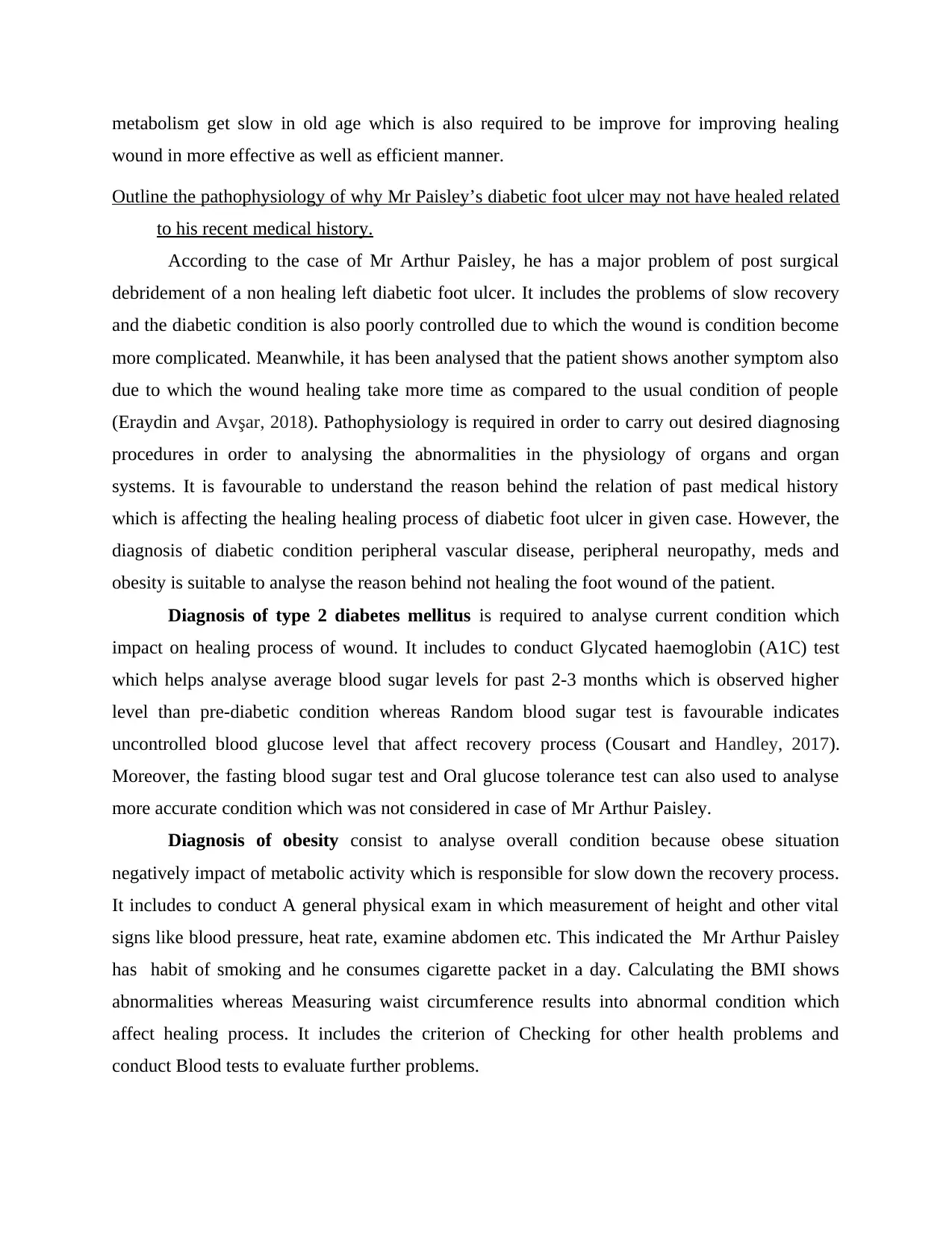
metabolism get slow in old age which is also required to be improve for improving healing
wound in more effective as well as efficient manner.
Outline the pathophysiology of why Mr Paisley’s diabetic foot ulcer may not have healed related
to his recent medical history.
According to the case of Mr Arthur Paisley, he has a major problem of post surgical
debridement of a non healing left diabetic foot ulcer. It includes the problems of slow recovery
and the diabetic condition is also poorly controlled due to which the wound is condition become
more complicated. Meanwhile, it has been analysed that the patient shows another symptom also
due to which the wound healing take more time as compared to the usual condition of people
(Eraydin and Avşar, 2018). Pathophysiology is required in order to carry out desired diagnosing
procedures in order to analysing the abnormalities in the physiology of organs and organ
systems. It is favourable to understand the reason behind the relation of past medical history
which is affecting the healing healing process of diabetic foot ulcer in given case. However, the
diagnosis of diabetic condition peripheral vascular disease, peripheral neuropathy, meds and
obesity is suitable to analyse the reason behind not healing the foot wound of the patient.
Diagnosis of type 2 diabetes mellitus is required to analyse current condition which
impact on healing process of wound. It includes to conduct Glycated haemoglobin (A1C) test
which helps analyse average blood sugar levels for past 2-3 months which is observed higher
level than pre-diabetic condition whereas Random blood sugar test is favourable indicates
uncontrolled blood glucose level that affect recovery process (Cousart and Handley, 2017).
Moreover, the fasting blood sugar test and Oral glucose tolerance test can also used to analyse
more accurate condition which was not considered in case of Mr Arthur Paisley.
Diagnosis of obesity consist to analyse overall condition because obese situation
negatively impact of metabolic activity which is responsible for slow down the recovery process.
It includes to conduct A general physical exam in which measurement of height and other vital
signs like blood pressure, heat rate, examine abdomen etc. This indicated the Mr Arthur Paisley
has habit of smoking and he consumes cigarette packet in a day. Calculating the BMI shows
abnormalities whereas Measuring waist circumference results into abnormal condition which
affect healing process. It includes the criterion of Checking for other health problems and
conduct Blood tests to evaluate further problems.
wound in more effective as well as efficient manner.
Outline the pathophysiology of why Mr Paisley’s diabetic foot ulcer may not have healed related
to his recent medical history.
According to the case of Mr Arthur Paisley, he has a major problem of post surgical
debridement of a non healing left diabetic foot ulcer. It includes the problems of slow recovery
and the diabetic condition is also poorly controlled due to which the wound is condition become
more complicated. Meanwhile, it has been analysed that the patient shows another symptom also
due to which the wound healing take more time as compared to the usual condition of people
(Eraydin and Avşar, 2018). Pathophysiology is required in order to carry out desired diagnosing
procedures in order to analysing the abnormalities in the physiology of organs and organ
systems. It is favourable to understand the reason behind the relation of past medical history
which is affecting the healing healing process of diabetic foot ulcer in given case. However, the
diagnosis of diabetic condition peripheral vascular disease, peripheral neuropathy, meds and
obesity is suitable to analyse the reason behind not healing the foot wound of the patient.
Diagnosis of type 2 diabetes mellitus is required to analyse current condition which
impact on healing process of wound. It includes to conduct Glycated haemoglobin (A1C) test
which helps analyse average blood sugar levels for past 2-3 months which is observed higher
level than pre-diabetic condition whereas Random blood sugar test is favourable indicates
uncontrolled blood glucose level that affect recovery process (Cousart and Handley, 2017).
Moreover, the fasting blood sugar test and Oral glucose tolerance test can also used to analyse
more accurate condition which was not considered in case of Mr Arthur Paisley.
Diagnosis of obesity consist to analyse overall condition because obese situation
negatively impact of metabolic activity which is responsible for slow down the recovery process.
It includes to conduct A general physical exam in which measurement of height and other vital
signs like blood pressure, heat rate, examine abdomen etc. This indicated the Mr Arthur Paisley
has habit of smoking and he consumes cigarette packet in a day. Calculating the BMI shows
abnormalities whereas Measuring waist circumference results into abnormal condition which
affect healing process. It includes the criterion of Checking for other health problems and
conduct Blood tests to evaluate further problems.
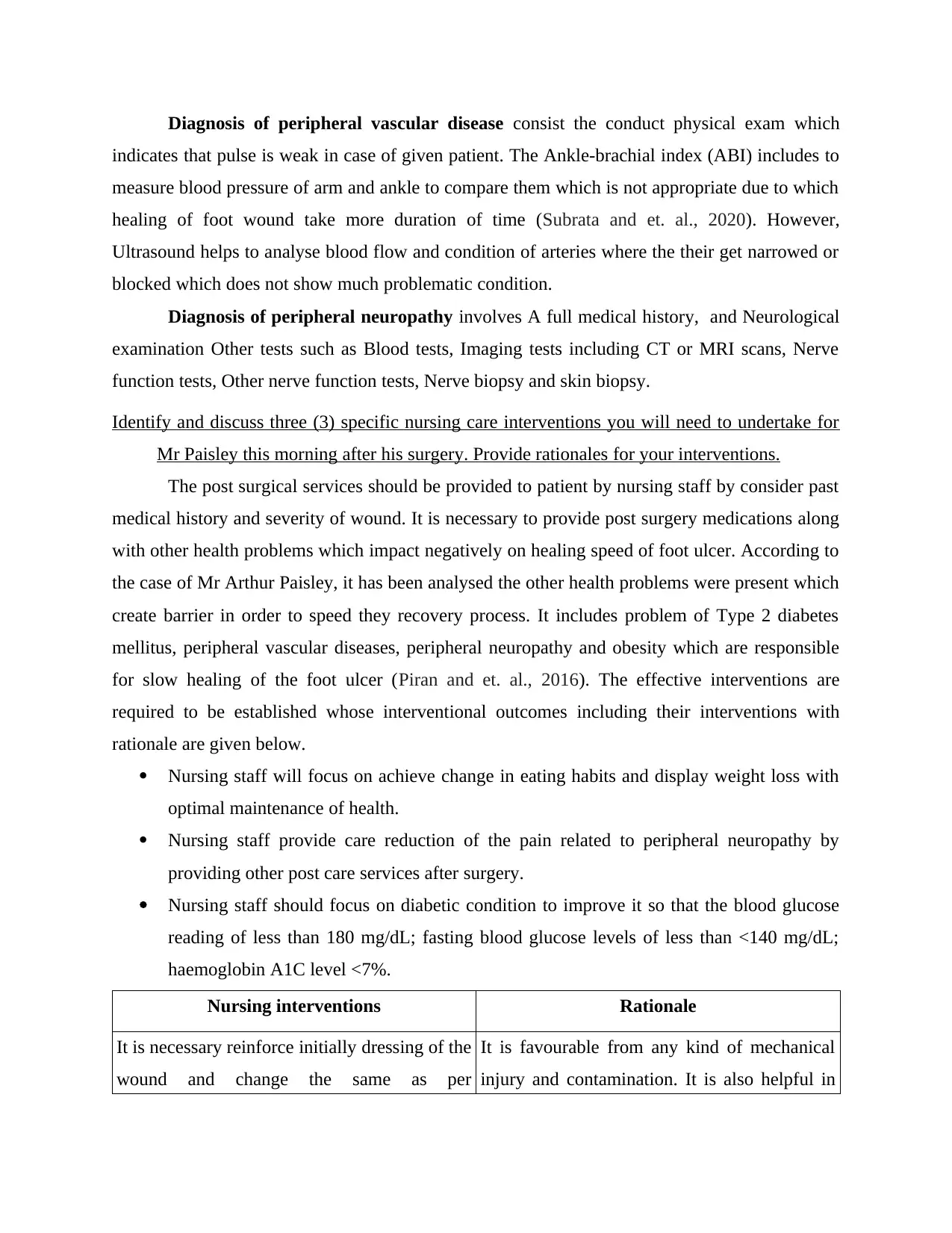
Diagnosis of peripheral vascular disease consist the conduct physical exam which
indicates that pulse is weak in case of given patient. The Ankle-brachial index (ABI) includes to
measure blood pressure of arm and ankle to compare them which is not appropriate due to which
healing of foot wound take more duration of time (Subrata and et. al., 2020). However,
Ultrasound helps to analyse blood flow and condition of arteries where the their get narrowed or
blocked which does not show much problematic condition.
Diagnosis of peripheral neuropathy involves A full medical history, and Neurological
examination Other tests such as Blood tests, Imaging tests including CT or MRI scans, Nerve
function tests, Other nerve function tests, Nerve biopsy and skin biopsy.
Identify and discuss three (3) specific nursing care interventions you will need to undertake for
Mr Paisley this morning after his surgery. Provide rationales for your interventions.
The post surgical services should be provided to patient by nursing staff by consider past
medical history and severity of wound. It is necessary to provide post surgery medications along
with other health problems which impact negatively on healing speed of foot ulcer. According to
the case of Mr Arthur Paisley, it has been analysed the other health problems were present which
create barrier in order to speed they recovery process. It includes problem of Type 2 diabetes
mellitus, peripheral vascular diseases, peripheral neuropathy and obesity which are responsible
for slow healing of the foot ulcer (Piran and et. al., 2016). The effective interventions are
required to be established whose interventional outcomes including their interventions with
rationale are given below.
Nursing staff will focus on achieve change in eating habits and display weight loss with
optimal maintenance of health.
Nursing staff provide care reduction of the pain related to peripheral neuropathy by
providing other post care services after surgery.
Nursing staff should focus on diabetic condition to improve it so that the blood glucose
reading of less than 180 mg/dL; fasting blood glucose levels of less than <140 mg/dL;
haemoglobin A1C level <7%.
Nursing interventions Rationale
It is necessary reinforce initially dressing of the
wound and change the same as per
It is favourable from any kind of mechanical
injury and contamination. It is also helpful in
indicates that pulse is weak in case of given patient. The Ankle-brachial index (ABI) includes to
measure blood pressure of arm and ankle to compare them which is not appropriate due to which
healing of foot wound take more duration of time (Subrata and et. al., 2020). However,
Ultrasound helps to analyse blood flow and condition of arteries where the their get narrowed or
blocked which does not show much problematic condition.
Diagnosis of peripheral neuropathy involves A full medical history, and Neurological
examination Other tests such as Blood tests, Imaging tests including CT or MRI scans, Nerve
function tests, Other nerve function tests, Nerve biopsy and skin biopsy.
Identify and discuss three (3) specific nursing care interventions you will need to undertake for
Mr Paisley this morning after his surgery. Provide rationales for your interventions.
The post surgical services should be provided to patient by nursing staff by consider past
medical history and severity of wound. It is necessary to provide post surgery medications along
with other health problems which impact negatively on healing speed of foot ulcer. According to
the case of Mr Arthur Paisley, it has been analysed the other health problems were present which
create barrier in order to speed they recovery process. It includes problem of Type 2 diabetes
mellitus, peripheral vascular diseases, peripheral neuropathy and obesity which are responsible
for slow healing of the foot ulcer (Piran and et. al., 2016). The effective interventions are
required to be established whose interventional outcomes including their interventions with
rationale are given below.
Nursing staff will focus on achieve change in eating habits and display weight loss with
optimal maintenance of health.
Nursing staff provide care reduction of the pain related to peripheral neuropathy by
providing other post care services after surgery.
Nursing staff should focus on diabetic condition to improve it so that the blood glucose
reading of less than 180 mg/dL; fasting blood glucose levels of less than <140 mg/dL;
haemoglobin A1C level <7%.
Nursing interventions Rationale
It is necessary reinforce initially dressing of the
wound and change the same as per
It is favourable from any kind of mechanical
injury and contamination. It is also helpful in
⊘ This is a preview!⊘
Do you want full access?
Subscribe today to unlock all pages.

Trusted by 1+ million students worldwide
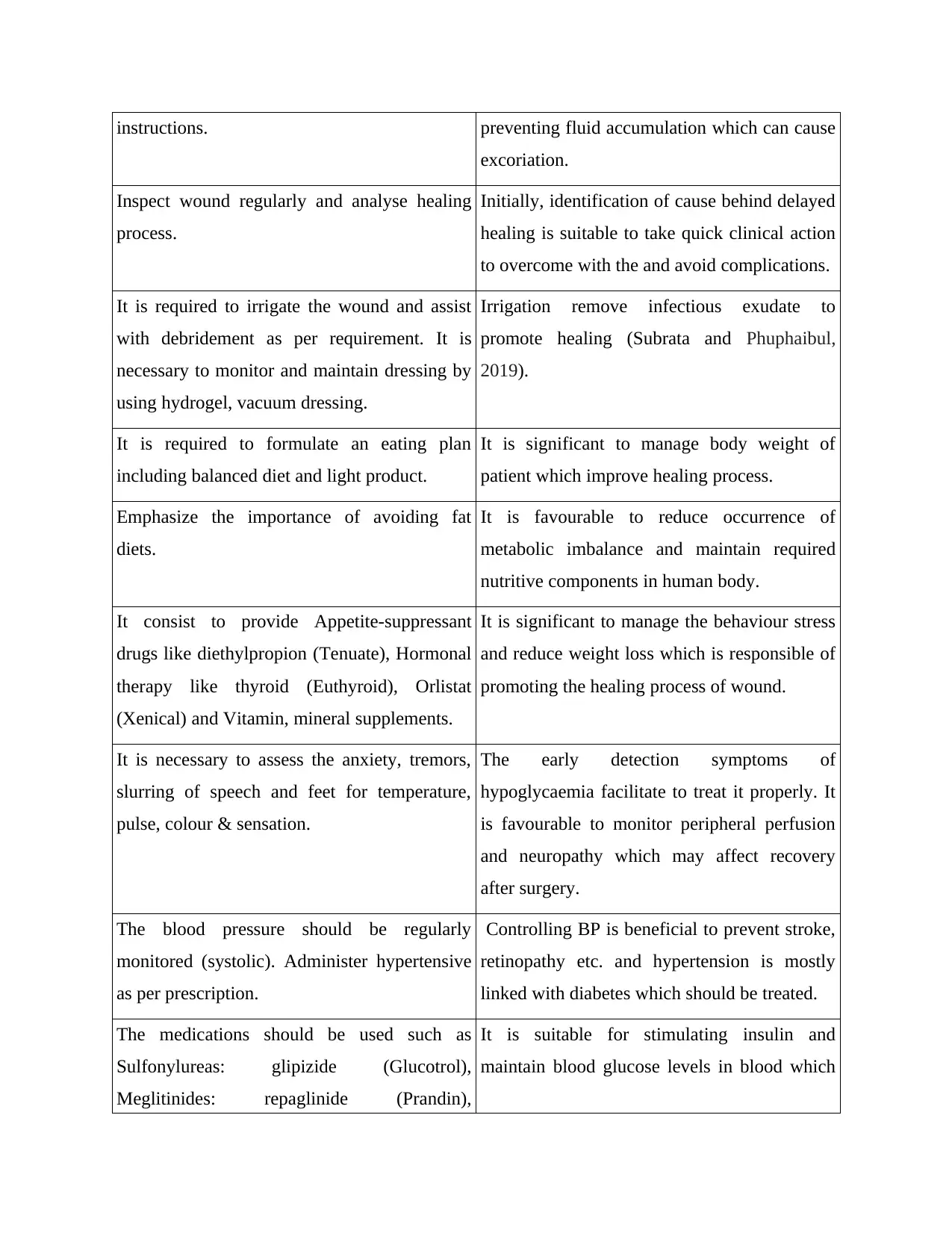
instructions. preventing fluid accumulation which can cause
excoriation.
Inspect wound regularly and analyse healing
process.
Initially, identification of cause behind delayed
healing is suitable to take quick clinical action
to overcome with the and avoid complications.
It is required to irrigate the wound and assist
with debridement as per requirement. It is
necessary to monitor and maintain dressing by
using hydrogel, vacuum dressing.
Irrigation remove infectious exudate to
promote healing (Subrata and Phuphaibul,
2019).
It is required to formulate an eating plan
including balanced diet and light product.
It is significant to manage body weight of
patient which improve healing process.
Emphasize the importance of avoiding fat
diets.
It is favourable to reduce occurrence of
metabolic imbalance and maintain required
nutritive components in human body.
It consist to provide Appetite-suppressant
drugs like diethylpropion (Tenuate), Hormonal
therapy like thyroid (Euthyroid), Orlistat
(Xenical) and Vitamin, mineral supplements.
It is significant to manage the behaviour stress
and reduce weight loss which is responsible of
promoting the healing process of wound.
It is necessary to assess the anxiety, tremors,
slurring of speech and feet for temperature,
pulse, colour & sensation.
The early detection symptoms of
hypoglycaemia facilitate to treat it properly. It
is favourable to monitor peripheral perfusion
and neuropathy which may affect recovery
after surgery.
The blood pressure should be regularly
monitored (systolic). Administer hypertensive
as per prescription.
Controlling BP is beneficial to prevent stroke,
retinopathy etc. and hypertension is mostly
linked with diabetes which should be treated.
The medications should be used such as
Sulfonylureas: glipizide (Glucotrol),
Meglitinides: repaglinide (Prandin),
It is suitable for stimulating insulin and
maintain blood glucose levels in blood which
excoriation.
Inspect wound regularly and analyse healing
process.
Initially, identification of cause behind delayed
healing is suitable to take quick clinical action
to overcome with the and avoid complications.
It is required to irrigate the wound and assist
with debridement as per requirement. It is
necessary to monitor and maintain dressing by
using hydrogel, vacuum dressing.
Irrigation remove infectious exudate to
promote healing (Subrata and Phuphaibul,
2019).
It is required to formulate an eating plan
including balanced diet and light product.
It is significant to manage body weight of
patient which improve healing process.
Emphasize the importance of avoiding fat
diets.
It is favourable to reduce occurrence of
metabolic imbalance and maintain required
nutritive components in human body.
It consist to provide Appetite-suppressant
drugs like diethylpropion (Tenuate), Hormonal
therapy like thyroid (Euthyroid), Orlistat
(Xenical) and Vitamin, mineral supplements.
It is significant to manage the behaviour stress
and reduce weight loss which is responsible of
promoting the healing process of wound.
It is necessary to assess the anxiety, tremors,
slurring of speech and feet for temperature,
pulse, colour & sensation.
The early detection symptoms of
hypoglycaemia facilitate to treat it properly. It
is favourable to monitor peripheral perfusion
and neuropathy which may affect recovery
after surgery.
The blood pressure should be regularly
monitored (systolic). Administer hypertensive
as per prescription.
Controlling BP is beneficial to prevent stroke,
retinopathy etc. and hypertension is mostly
linked with diabetes which should be treated.
The medications should be used such as
Sulfonylureas: glipizide (Glucotrol),
Meglitinides: repaglinide (Prandin),
It is suitable for stimulating insulin and
maintain blood glucose levels in blood which
Paraphrase This Document
Need a fresh take? Get an instant paraphrase of this document with our AI Paraphraser
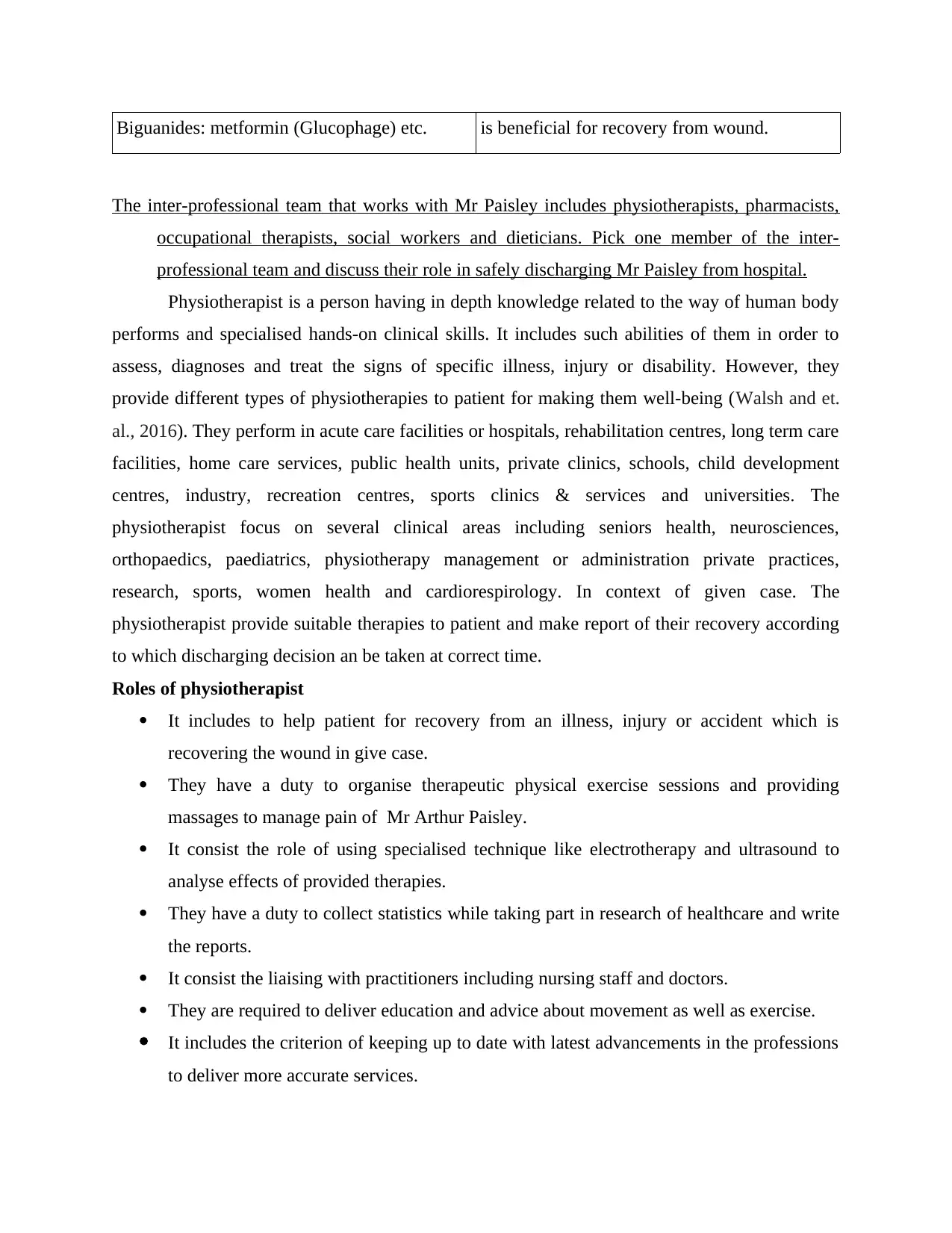
Biguanides: metformin (Glucophage) etc. is beneficial for recovery from wound.
The inter-professional team that works with Mr Paisley includes physiotherapists, pharmacists,
occupational therapists, social workers and dieticians. Pick one member of the inter-
professional team and discuss their role in safely discharging Mr Paisley from hospital.
Physiotherapist is a person having in depth knowledge related to the way of human body
performs and specialised hands-on clinical skills. It includes such abilities of them in order to
assess, diagnoses and treat the signs of specific illness, injury or disability. However, they
provide different types of physiotherapies to patient for making them well-being (Walsh and et.
al., 2016). They perform in acute care facilities or hospitals, rehabilitation centres, long term care
facilities, home care services, public health units, private clinics, schools, child development
centres, industry, recreation centres, sports clinics & services and universities. The
physiotherapist focus on several clinical areas including seniors health, neurosciences,
orthopaedics, paediatrics, physiotherapy management or administration private practices,
research, sports, women health and cardiorespirology. In context of given case. The
physiotherapist provide suitable therapies to patient and make report of their recovery according
to which discharging decision an be taken at correct time.
Roles of physiotherapist
It includes to help patient for recovery from an illness, injury or accident which is
recovering the wound in give case.
They have a duty to organise therapeutic physical exercise sessions and providing
massages to manage pain of Mr Arthur Paisley.
It consist the role of using specialised technique like electrotherapy and ultrasound to
analyse effects of provided therapies.
They have a duty to collect statistics while taking part in research of healthcare and write
the reports.
It consist the liaising with practitioners including nursing staff and doctors.
They are required to deliver education and advice about movement as well as exercise.
It includes the criterion of keeping up to date with latest advancements in the professions
to deliver more accurate services.
The inter-professional team that works with Mr Paisley includes physiotherapists, pharmacists,
occupational therapists, social workers and dieticians. Pick one member of the inter-
professional team and discuss their role in safely discharging Mr Paisley from hospital.
Physiotherapist is a person having in depth knowledge related to the way of human body
performs and specialised hands-on clinical skills. It includes such abilities of them in order to
assess, diagnoses and treat the signs of specific illness, injury or disability. However, they
provide different types of physiotherapies to patient for making them well-being (Walsh and et.
al., 2016). They perform in acute care facilities or hospitals, rehabilitation centres, long term care
facilities, home care services, public health units, private clinics, schools, child development
centres, industry, recreation centres, sports clinics & services and universities. The
physiotherapist focus on several clinical areas including seniors health, neurosciences,
orthopaedics, paediatrics, physiotherapy management or administration private practices,
research, sports, women health and cardiorespirology. In context of given case. The
physiotherapist provide suitable therapies to patient and make report of their recovery according
to which discharging decision an be taken at correct time.
Roles of physiotherapist
It includes to help patient for recovery from an illness, injury or accident which is
recovering the wound in give case.
They have a duty to organise therapeutic physical exercise sessions and providing
massages to manage pain of Mr Arthur Paisley.
It consist the role of using specialised technique like electrotherapy and ultrasound to
analyse effects of provided therapies.
They have a duty to collect statistics while taking part in research of healthcare and write
the reports.
It consist the liaising with practitioners including nursing staff and doctors.
They are required to deliver education and advice about movement as well as exercise.
It includes the criterion of keeping up to date with latest advancements in the professions
to deliver more accurate services.
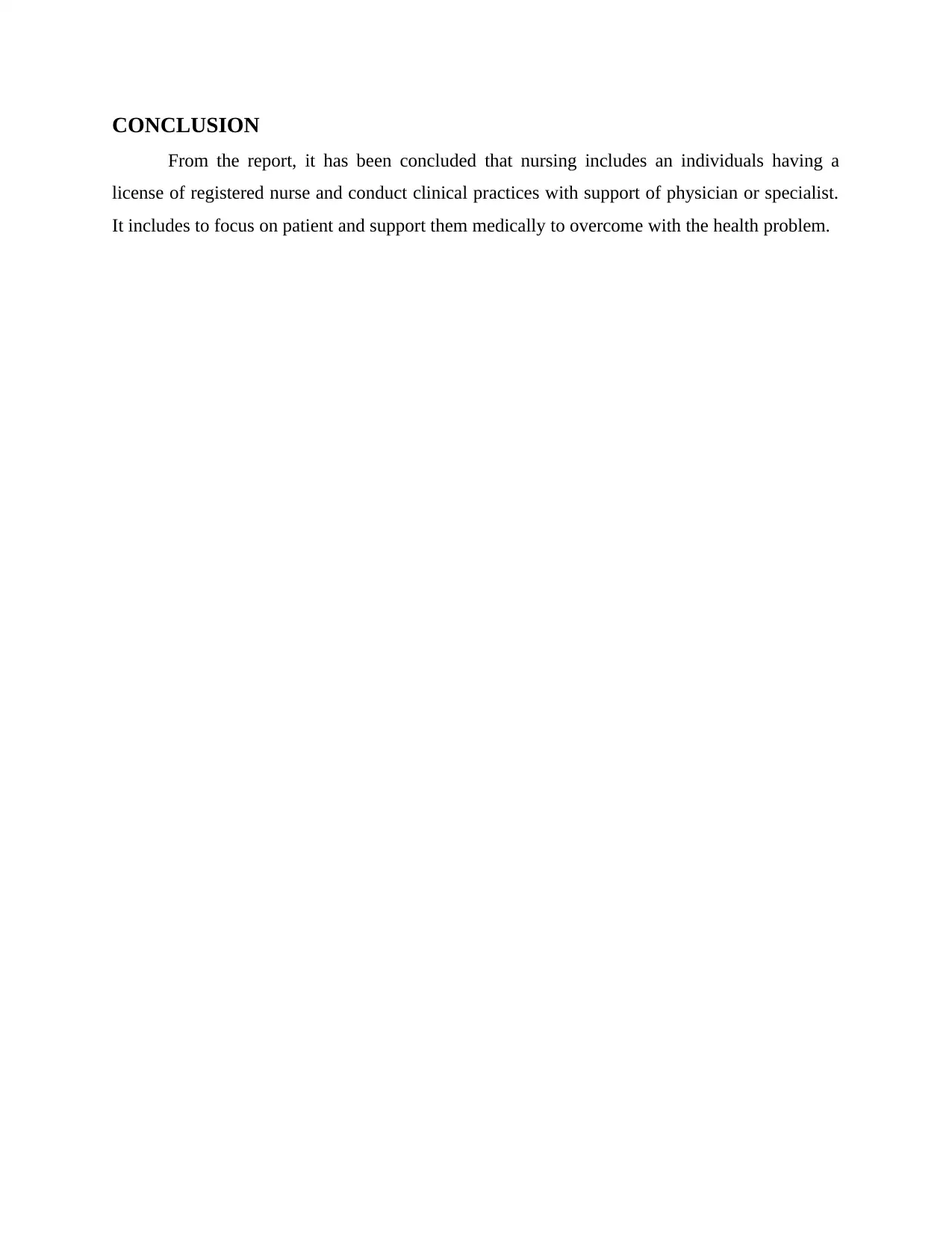
CONCLUSION
From the report, it has been concluded that nursing includes an individuals having a
license of registered nurse and conduct clinical practices with support of physician or specialist.
It includes to focus on patient and support them medically to overcome with the health problem.
From the report, it has been concluded that nursing includes an individuals having a
license of registered nurse and conduct clinical practices with support of physician or specialist.
It includes to focus on patient and support them medically to overcome with the health problem.
⊘ This is a preview!⊘
Do you want full access?
Subscribe today to unlock all pages.

Trusted by 1+ million students worldwide
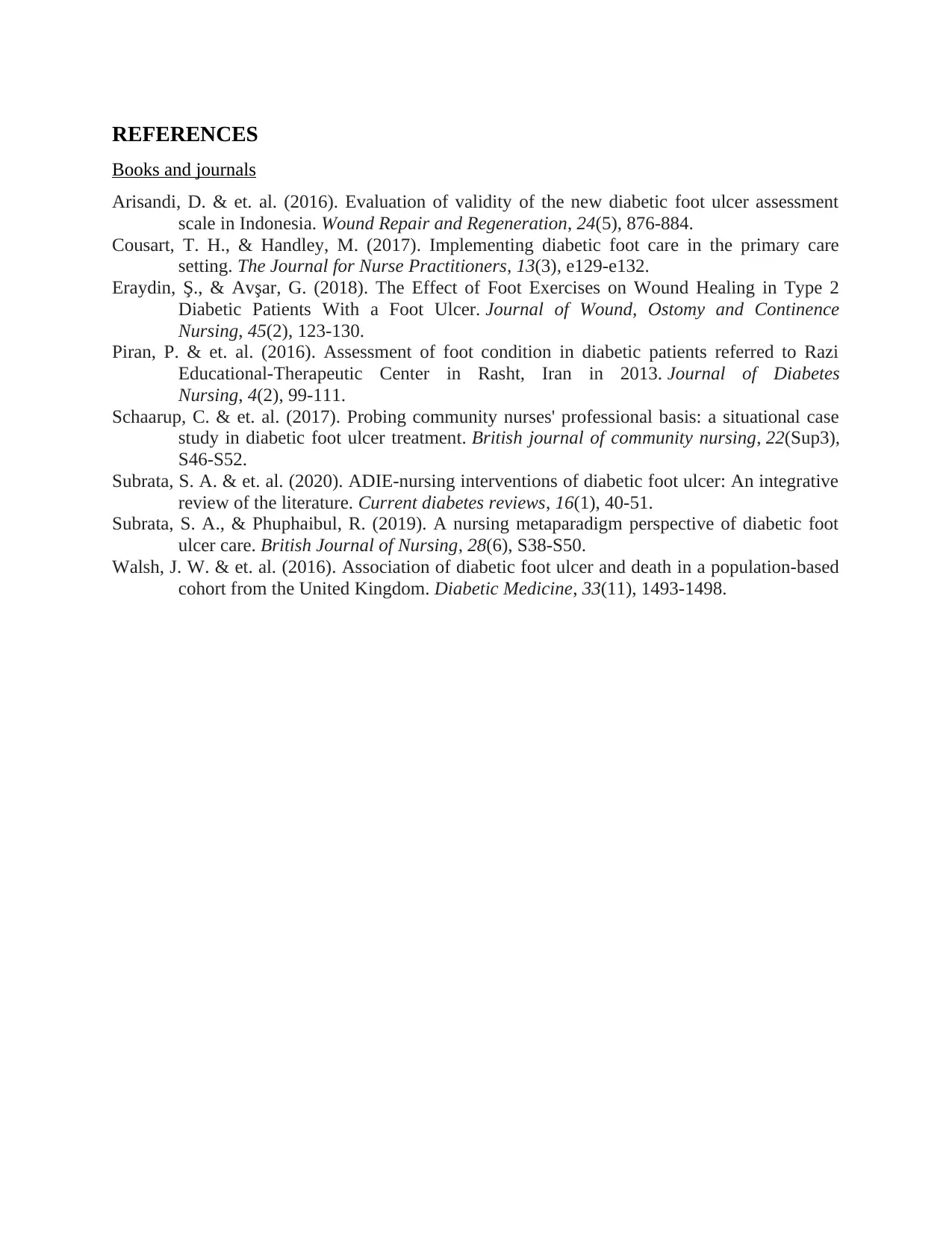
REFERENCES
Books and journals
Arisandi, D. & et. al. (2016). Evaluation of validity of the new diabetic foot ulcer assessment
scale in Indonesia. Wound Repair and Regeneration, 24(5), 876-884.
Cousart, T. H., & Handley, M. (2017). Implementing diabetic foot care in the primary care
setting. The Journal for Nurse Practitioners, 13(3), e129-e132.
Eraydin, Ş., & Avşar, G. (2018). The Effect of Foot Exercises on Wound Healing in Type 2
Diabetic Patients With a Foot Ulcer. Journal of Wound, Ostomy and Continence
Nursing, 45(2), 123-130.
Piran, P. & et. al. (2016). Assessment of foot condition in diabetic patients referred to Razi
Educational-Therapeutic Center in Rasht, Iran in 2013. Journal of Diabetes
Nursing, 4(2), 99-111.
Schaarup, C. & et. al. (2017). Probing community nurses' professional basis: a situational case
study in diabetic foot ulcer treatment. British journal of community nursing, 22(Sup3),
S46-S52.
Subrata, S. A. & et. al. (2020). ADIE-nursing interventions of diabetic foot ulcer: An integrative
review of the literature. Current diabetes reviews, 16(1), 40-51.
Subrata, S. A., & Phuphaibul, R. (2019). A nursing metaparadigm perspective of diabetic foot
ulcer care. British Journal of Nursing, 28(6), S38-S50.
Walsh, J. W. & et. al. (2016). Association of diabetic foot ulcer and death in a population‐based
cohort from the United Kingdom. Diabetic Medicine, 33(11), 1493-1498.
Books and journals
Arisandi, D. & et. al. (2016). Evaluation of validity of the new diabetic foot ulcer assessment
scale in Indonesia. Wound Repair and Regeneration, 24(5), 876-884.
Cousart, T. H., & Handley, M. (2017). Implementing diabetic foot care in the primary care
setting. The Journal for Nurse Practitioners, 13(3), e129-e132.
Eraydin, Ş., & Avşar, G. (2018). The Effect of Foot Exercises on Wound Healing in Type 2
Diabetic Patients With a Foot Ulcer. Journal of Wound, Ostomy and Continence
Nursing, 45(2), 123-130.
Piran, P. & et. al. (2016). Assessment of foot condition in diabetic patients referred to Razi
Educational-Therapeutic Center in Rasht, Iran in 2013. Journal of Diabetes
Nursing, 4(2), 99-111.
Schaarup, C. & et. al. (2017). Probing community nurses' professional basis: a situational case
study in diabetic foot ulcer treatment. British journal of community nursing, 22(Sup3),
S46-S52.
Subrata, S. A. & et. al. (2020). ADIE-nursing interventions of diabetic foot ulcer: An integrative
review of the literature. Current diabetes reviews, 16(1), 40-51.
Subrata, S. A., & Phuphaibul, R. (2019). A nursing metaparadigm perspective of diabetic foot
ulcer care. British Journal of Nursing, 28(6), S38-S50.
Walsh, J. W. & et. al. (2016). Association of diabetic foot ulcer and death in a population‐based
cohort from the United Kingdom. Diabetic Medicine, 33(11), 1493-1498.
1 out of 10
Related Documents
Your All-in-One AI-Powered Toolkit for Academic Success.
+13062052269
info@desklib.com
Available 24*7 on WhatsApp / Email
![[object Object]](/_next/static/media/star-bottom.7253800d.svg)
Unlock your academic potential
© 2024 | Zucol Services PVT LTD | All rights reserved.





